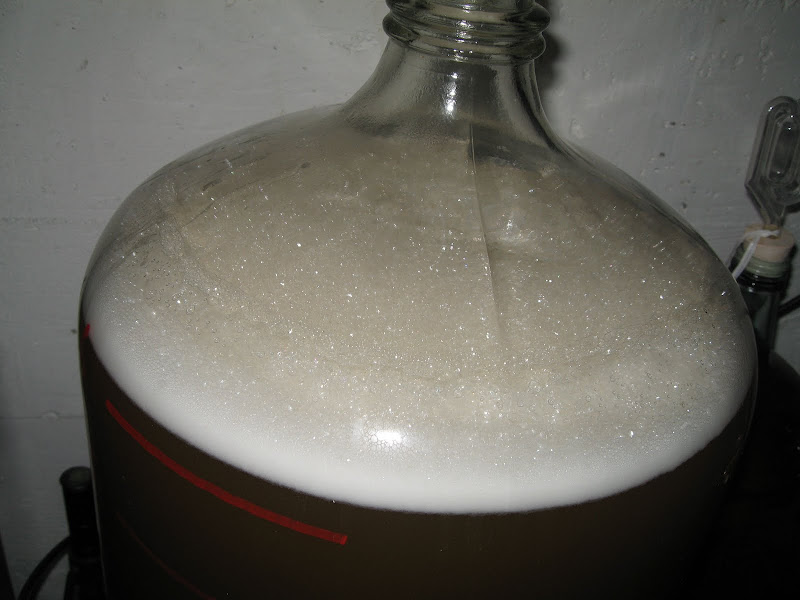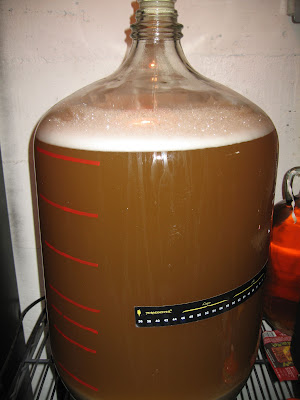Racked mine yesterday after seven weeks. The wild version wasn't very sour at all, was down to 1.000. I'll let it condition for awhile and then add some acid to the keg to taste. The 5335 version smelled like lemonade so I think the acid level is a lot better in that one. I didn't take a reading yet, I'll let it sit in the secondary for a bit and then take a reading. I was being careful (paranoid) to avoid cross contaminating each half batch with the other.
You are using an out of date browser. It may not display this or other websites correctly.
You should upgrade or use an alternative browser.
You should upgrade or use an alternative browser.
Spurhund Zunge
- Thread starter flyangler18
- Start date

Help Support Homebrew Talk:
This site may earn a commission from merchant affiliate
links, including eBay, Amazon, and others.
scinerd3000
Well-Known Member
im still at a loss understanding when to tell if its done. Considering aging this in secondary will it just continue to drop below 1.003 if i dont rack off or with metabisulfite as you suggested?
flyangler18
Well-Known Member
im still at a loss understanding when to tell if its done. Considering aging this in secondary will it just continue to drop below 1.003 if i dont rack off or with metabisulfite as you suggested?
The activity of the Lactobacillus is limited by the concentration of lactic acid in solution, around 1% if I recall correctly to a pH of 3.8.
ohiobrewtus
Well-Known Member
I finally tapped mine and this is excellent stuff. I didn't pitch any sacc. in mine, just the 5335. I had 1/2 of a keg left and all the BMC guzzlers that came over for a poker game killed my damn keg!
My wild version is on draft and is tasting good now after adding a few tablespoons of lactic acid to bring up the acidity. It has an off aroma, rather vegetal-like, which I am 110% sure is from an unwanted infection from the grain. However as long as you hold your breath it tastes great!  The other half made with the 5335 is better, and I'm letting it age until the first keg kicks.
The other half made with the 5335 is better, and I'm letting it age until the first keg kicks.
Mine is way too sour! Ive been blending it with a medicore beer, and 1+1=3! so im fine with it!
![Craft A Brew - Safale S-04 Dry Yeast - Fermentis - English Ale Dry Yeast - For English and American Ales and Hard Apple Ciders - Ingredients for Home Brewing - Beer Making Supplies - [1 Pack]](https://m.media-amazon.com/images/I/41fVGNh6JfL._SL500_.jpg)
$6.95 ($17.38 / Ounce)
$7.47 ($18.68 / Ounce)
Craft A Brew - Safale S-04 Dry Yeast - Fermentis - English Ale Dry Yeast - For English and American Ales and Hard Apple Ciders - Ingredients for Home Brewing - Beer Making Supplies - [1 Pack]
Hobby Homebrew

$58.16
HUIZHUGS Brewing Equipment Keg Ball Lock Faucet 30cm Reinforced Silicone Hose Secondary Fermentation Homebrew Kegging Brewing Equipment
xiangshuizhenzhanglingfengshop

$53.24
1pc Hose Barb/MFL 1.5" Tri Clamp to Ball Lock Post Liquid Gas Homebrew Kegging Fermentation Parts Brewer Hardware SUS304(Liquid Hose Barb)
Guangshui Weilu You Trading Co., Ltd

$53.24
1pc Hose Barb/MFL 1.5" Tri Clamp to Ball Lock Post Liquid Gas Homebrew Kegging Fermentation Parts Brewer Hardware SUS304(Liquid Hose Barb)
yunchengshiyanhuqucuichendianzishangwuyouxiangongsi

$7.79 ($7.79 / Count)
Craft A Brew - LalBrew Voss™ - Kveik Ale Yeast - For Craft Lagers - Ingredients for Home Brewing - Beer Making Supplies - (1 Pack)
Craft a Brew

$10.99 ($31.16 / Ounce)
Hornindal Kveik Yeast for Homebrewing - Mead, Cider, Wine, Beer - 10g Packet - Saccharomyces Cerevisiae - Sold by Shadowhive.com
Shadowhive

$22.00 ($623.23 / Ounce)
AMZLMPKNTW Ball Lock Sample Faucet 30cm Reinforced Silicone Hose Secondary Fermentation Homebrew Kegging joyful
无为中南商贸有限公司

$20.94
$29.99
The Brew Your Own Big Book of Clone Recipes: Featuring 300 Homebrew Recipes from Your Favorite Breweries
Amazon.com

$33.95
Five Star - 6022b_ - Star San - 32 Ounce - High Foaming Sanitizer
Bridgeview Beer and Wine Supply

$27.29 ($13.64 / Count)
$41.99 ($21.00 / Count)
2 Pack 1 Gallon Large Fermentation Jars with 3 Airlocks and 2 SCREW Lids(100% Airtight Heavy Duty Lid w Silicone) - Wide Mouth Glass Jars w Scale Mark - Pickle Jars for Sauerkraut, Sourdough Starter
Qianfenie Direct

$39.22 ($39.22 / Count)
Brewer's Best Home Brew Beer Ingredient Kit - 5 Gallon (Mexican Cerveza)
Amazon.com

$176.97
1pc Commercial Keg Manifold 2" Tri Clamp,Ball Lock Tapping Head,Pressure Gauge/Adjustable PRV for Kegging,Fermentation Control
hanhanbaihuoxiaoshoudian
user 22118
Well-Known Member
- Joined
- Jul 4, 2008
- Messages
- 2,023
- Reaction score
- 13
Ohio Brewtus, I read that lacto will just eat sugar and produce lactic acid. Did you ever only drink it and get drunk? I just want to know because I am about to do a sour.
They are a major part of the lactic acid bacteria group, named as such because most of its members convert lactose and other sugars to lactic acid.
cmdrico7812
Well-Known Member
So when you decide that the sourness is good, do you just rack from under the pellicle? Won't the lacto continue to eat? How do you prevent continued fermentation and bottle bombs? Do you just have to drink it fast?
I know this was posted a long time ago in this thread, but could someone answer this for me? My brain is telling me that when I prime and bottle this BW, the funk will continue in the bottle. How do you stop this process, or do you just not worry about it and bottle it as you would anything else? Thanks.
A little bit of fruit juice added to this stuff is the schnizzle. This will be a summer staple for me in the future.
flyangler18
Well-Known Member
An excellent start to the weekend! Just pulled a quick sampler to see how the newest batch is progressing.


This looks amazing, this may be one of my beers for next summer 
bhatchable
Well-Known Member
anyone think that adding some citrus zest, or maybe grains of paradise (or both!) to this would be worthwhile?
also, i've got a white labs trappist ale yeast in the fridge... will this work out as the sacc pitch for this style?
lastly, as far as repitching on the cake with another batch (since the grain bill is so inexpensive... pipeline expansion on the cheap!) will it work well? what differences can be expected? should I pitch new lacto then plan to rack onto the cake from the first batch to account for the growth rate of the sacc? or is there enough lacto left in the cake to do the job? so many questions!!!
also, i've got a white labs trappist ale yeast in the fridge... will this work out as the sacc pitch for this style?
lastly, as far as repitching on the cake with another batch (since the grain bill is so inexpensive... pipeline expansion on the cheap!) will it work well? what differences can be expected? should I pitch new lacto then plan to rack onto the cake from the first batch to account for the growth rate of the sacc? or is there enough lacto left in the cake to do the job? so many questions!!!
This beer took third place in 17A at the HBT 2009 comp. I can't take credit since it totally isn't my recipe so I linked here and am bumping the thread. 

flyangler18
Well-Known Member
This beer took third place in 17A at the HBT 2009 comp. I can't take credit since it totally isn't my recipe so I linked here and am bumping the thread.
Sweet!
ohiobrewtus
Well-Known Member
This beer took third place in 17A at the HBT 2009 comp. I can't take credit since it totally isn't my recipe so I linked here and am bumping the thread.
It actually took 3rd place twice, since Sacc and I tied for that spot. I only pitched bugs, but other than that it's FA's recipe.
bhatchable
Well-Known Member
so i typed in the name of this one into a german to english translator and it gave me "track dog tongue." anyone care to shed some light on the translation?
flyangler18
Well-Known Member
so i typed in the name of this one into a german to english translator and it gave me "track dog tongue." anyone care to shed some light on the translation?
Sure, I named it 'Hound's Tongue', after my beagle.
bhatchable
Well-Known Member
sweet! beagles are amazing
adx
Well-Known Member
This just sky rocketed to the top of my "To Brew" list. I already ordered the yeast and lacto for it.
Edcculus
Well-Known Member
This just sky rocketed to the top of my "To Brew" list. I already ordered the yeast and lacto for it.
me too, right after the 10-10-10. Come to think of it, this will make 3 of Flyangler's recipes in a row. I brewed his smoked porter last weekend
flyangler18
Well-Known Member
me too, right after the 10-10-10. Come to think of it, this will make 3 of Flyangler's recipes in a row. I brewed his smoked porter last weekend
:rockin::rockin::rockin:
bhatchable
Well-Known Member
I just tasted this while transfering to secondary. it has been in primary for 3 weeks. it is starting to get tart. 1.006 right now. amazing recipe flyangler. thanks
flyangler18
Well-Known Member
Cool - now leave it alone for a couple more months and you'll be rewarded with a pellicle of sorts. Quite a sight. 
bhatchable
Well-Known Member
nice. it was starting to get splochy white dots on top, i think pretty standard for the look of lacto d. i just wanted to get it off of the yeast cake before extended bulk aging. stoked to try this one
adx
Well-Known Member
Just a quick question. Do you move this to a secondary or just keep it in a primary on the yeast for the bulk aging?
Just a quick question. Do you move this to a secondary or just keep it in a primary on the yeast for the bulk aging?
mine has been in the primary for almost 3 months
flyangler18
Well-Known Member
Im botteling all my beers, how do i keep the white stuff out of my bottels ?
Rack carefully.
Chester
Well-Known Member
Brewed this yesterday. pitched lacto at 3:00 pm so now 21 hours in. I've been holding the temp @ 90 deg. just took off the blanket and heating pad. air lock is bubbling away. Is that lacto only krausen? I took a wiff of the airlock and it smells pretty good and sour. I thought L. Delbrueckii was homofermentative, producing only lactic aci?. Did I contaminate my bugs with some yeast somehow? Or is it suppose to look like that. I've never pitched lacto by itself before.


Now I'm gonna let it cool in my garage to 65 and pitch my starter,


Now I'm gonna let it cool in my garage to 65 and pitch my starter,
bhatchable
Well-Known Member
^yeah, that is how my lacto looked prior to pitching the sacc.
I am about ready to bottle mine now, it is pretty mouth puckering. I put my carboy into the fridge to cold crash it. will the lacto film on top drop out with cold crashing or will i just need to rack from under it?
I am about ready to bottle mine now, it is pretty mouth puckering. I put my carboy into the fridge to cold crash it. will the lacto film on top drop out with cold crashing or will i just need to rack from under it?
Similar threads
- Replies
- 0
- Views
- 2K
- Replies
- 4
- Views
- 3K












































